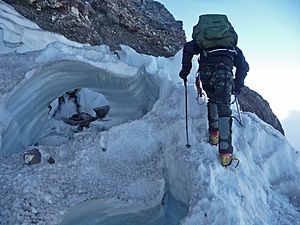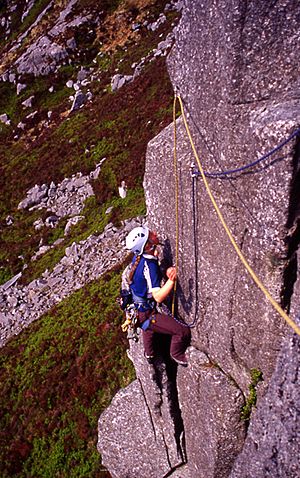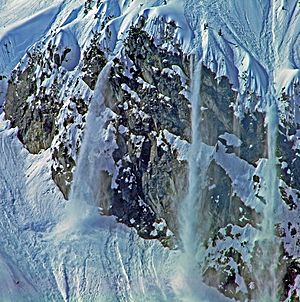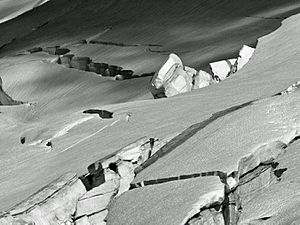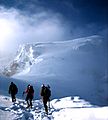Mountain climbing facts for kids
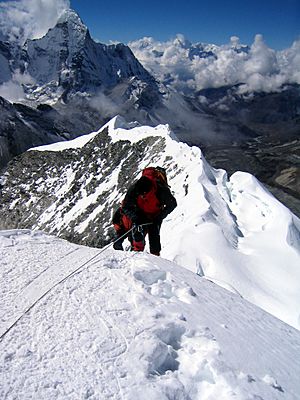
Mountain climbing is an exciting sport where people climb tall mountains. It's also called mountaineering. This activity can include hiking (walking), scrambling (climbing with hands and feet), rock climbing, and even crossing icy glaciers. Someone who climbs mountains is known as a mountain climber.
Mountain climbers use their arm and leg strength to move up mountains. They often use special ropes, sturdy shoes, and other safety gear. For most people, mountain climbing is a fun hobby or a way to enjoy the outdoors. A few people even do it as a job. They might work for outdoor gear companies or universities. Some also work as guides for other climbers.
Contents
Risks of Mountain Climbing
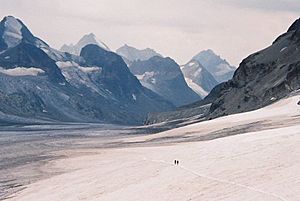
Climbing mountains can be risky. Each year, some people get hurt badly or even lose their lives. This can happen from falling, being caught in a snow avalanche, or getting too cold. To stay safer, climbers learn how to climb carefully. They also use safety gear like helmets, ropes, compasses, and first aid kits.
In snowy areas, where avalanches are a danger, climbers bring extra tools. These include shovels, radio transmitters, and long poles. These items help them find people buried in the snow.
Falling Rocks
Every rock mountain slowly breaks down over time. This process is called erosion. It happens faster high up where there is snow. Rocks can fall from mountain faces at any time. Climbers usually try to avoid these falling stones.
Falling rocks often create paths or grooves in the mountain face. These are called couloirs. Climbers must be careful when going up these paths. The sides of the couloirs are often safer than the middle. Rocks fall more often on some days than others. This depends on the recent weather. Ice that forms overnight can hold rocks in place. But warm weather or direct sunlight can make them fall. Knowing about typical rockfall on a route is very helpful.
When rocks fall with slushy snow or water, they can form a mud avalanche. These are common in the Himalaya. It is important not to camp where these might fall.
Falling Ice
Climbers can usually tell where ice might fall. It often comes from broken parts of glaciers called seracs. It also falls from overhanging ice ledges on narrow ridges. Large icicles can form on steep rock faces. They often fall on sunny days after cold, stormy weather. Climbers must avoid these areas, just like falling rocks.
Seracs form slowly and move with the glacier. They usually fall during or after the warmest part of the day. Their broken pieces don't travel very far. A skilled climber can find a safe path through tricky ice. But it's best to avoid these spots on a hot afternoon. Glaciers hanging on steep slopes can also break off. Their pieces fall onto the rocks below. Climbers can spot these areas by the ice debris. Their paths should be avoided.
Snow Avalanches
Avalanches are a major danger in the mountains. Many people think they can spot the danger and survive if caught. But the truth is different. Many people get hurt or worse in avalanches each year. Most are experienced skiers or climbers. There is often pressure to cross a snowy slope. Turning back takes time and effort. It also needs strong leadership. It's hard to turn back when others are crossing the slope. But the next person could cause an avalanche.
There are two main types of avalanches:
- Slab avalanche: This happens when a large sheet of snow breaks loose and slides down. These are the biggest and most dangerous.
- Hard Slab Avalanche: Formed by hard, packed snow in a solid sheet. This slab does not break up easily as it slides. It results in large blocks tumbling down the mountain.
- Soft Slab: This is also a connected layer of snow. But this slab tends to break apart more easily.
- Loose snow avalanche: This type starts with a small amount of moving snow. It then gathers more snow as it slides, becoming bigger. It is also called a "wet slide." This avalanche can still knock a climber or skier off their feet. It can bury them or sweep them over a cliff.
Dangerous slides often happen on slopes that skiers like. These are long, wide open, and have few trees or large rocks. They are usually angled between 30 and 45 degrees. They are also common after a big snowstorm. Slopes facing away from the wind are also risky. Sunlight can also trigger slides. These are usually loose snow or wet slides. The extra weight of a wet slide can sometimes trigger a slab avalanche. Most people caught in avalanches trigger them themselves or with their group.
When going off marked trails or in alpine areas, groups should always carry:
- Avalanche beacons (to find buried people)
- Probes (long poles to search for buried people)
- Shovels (much faster than hands for digging)
It is also very important to have avalanche training! Even with the right gear and training, there is a chance of getting hurt badly if caught in a big avalanche. If buried for more than a few minutes, the chance of being found alive drops. The best way to stay safe is to learn how to avoid risky conditions.
- See also avalanche for more information on dangers and safety.
Falls from Rocks
A good rock climber knows how to choose handholds and footholds. They also know how to stick to them. It's important to guess correctly how strong a rock is before putting weight on it. Many loose rocks can hold a person's weight. But it takes experience to know which ones are safe. Skill is needed to shift weight without sudden movements.
On crumbly rocks, the rope must be handled carefully. This is to avoid knocking loose stones onto climbers below. Handholds and footholds also need this care. When moving sideways across very difficult rocks, it can be dangerous. This is unless there are strong positions at both ends of the traverse. Climbers help each other in many ways on hard rocks. Two or three people might climb on each other's shoulders. Or they might use an ice axe held by others as a foothold. The main idea is teamwork. Everyone in the group climbs together, not alone. Each person must know what the climber in front and behind them is doing. After bad weather, steep rocks can be covered in a thin layer of ice. This ice is called verglas. It can make climbing very hard. Crampons (spikes for boots) are helpful in these situations.
Ice Slopes
For walking on slopes made of ice or hard snow, crampons are a must-have. Climbers can sometimes cut steps into snow slopes that are not too steep. But this is slow and tiring. It also doesn't offer as much safety as crampons. However, in soft or powdery snow, crampons can get clogged with snow. This makes them less effective.
In both cases, an ice axe helps with balance. It also lets the climber stop themselves if they slip or fall. On a true ice slope, however, an ice axe is rarely enough to stop a fall. For extra safety on steep ice slopes, the climbing rope is attached to ice screws. These screws are drilled into the ice.
True ice slopes are not common in Europe. But they are often found in mountains in tropical areas. There, new snow melts on the surface and gets wet underneath. Then, the next night's frost turns it into solid ice.
Snow Slopes
Snow slopes are very common. They are usually easy to climb. At the bottom of a snow or ice slope, there is often a big crack. This crack is called a bergschrund. It forms where the mountain's slope rises from a snowfield or glacier. These bergschrunds are usually too wide to step over. Climbers must cross them using a snow bridge. This bridge needs careful testing. The rope must be used with great care.
A steep snow slope in bad condition can be dangerous. The entire body of snow might start to slide as an avalanche. Such slopes are less dangerous if climbed straight up. Climbing across them (obliquely) can cut the snow. This makes it easier for the whole mass to move. New snow lying on ice is especially risky. Experience is needed to decide if it's safe to go over snow in doubtful conditions. Snow on rocks is usually weak unless it's very thick. Snow on other snow is likely to be strong. A day or two of good weather usually makes new snow safe.
Snow cannot lie at a very steep angle. But it often looks steeper than it is. Snow slopes rarely go beyond 40 degrees. Ice slopes can be much steeper. Snow slopes are usually hard and safe in the early morning. But they become soft and possibly dangerous in the afternoon. This is why climbers often start early.
Crevasses
Crevasses are deep cracks or chasms in a glacier. They form as the glacier moves over uneven ground. They can be open or hidden. In the lower parts of a glacier, crevasses are usually open. But higher up, above the snow-line, they are often covered by snow bridges. Finding hidden crevasses needs care and experience. After fresh snowfall, they can only be found by poking the ground with an ice axe pole. Or by looking for where a hidden crevasse might extend openly to the side.
The best way to stay safe from crevasses is to use a rope. No one should ever cross a snow-covered glacier alone. They should always be roped to one or two other climbers. Anyone going onto crevasses should also be trained in crevasse rescue.
Images for kids
-
Mountain climbers ascending Mount Rainier looking at Little Tahoma Peak
-
Edward Whymper (1840–1911), painting by Lance Calkin
-
Edelweiss, a plant associated with mountain sports
-
Granite Park Chalet in Glacier National Park, US
See also
 In Spanish: Montañismo para niños
In Spanish: Montañismo para niños


